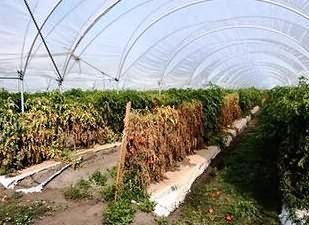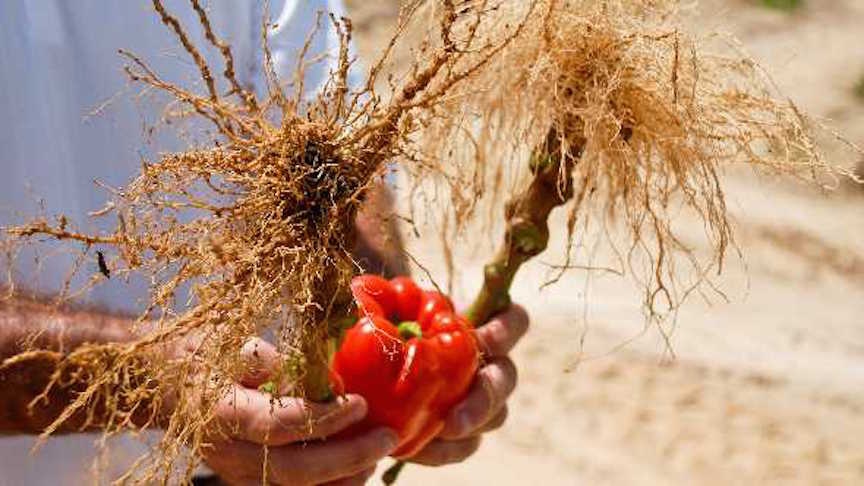पॉलीहाउस में पादप परजीवी निमेटोड का प्रबंधन
Protected cultivation is an emerging technology for raising high value vegetable and ornamental crops under controlled environmental conditions which gives manifold increase in yield per unit area and is being done with green house, shade net, plastic tunnel and mulch. The application of polyhouse technology is feasible in the tropical and subtropical climatic conditions of India.
Under polyhouse condition, high temperature and relative humidity with general poor plant hygienic conditions provide ideal conditions for the introduction and rapid multiplication of various insect-pests including plant parasitic nematodes (PPNs). Among PPNs, Meloidogyne spp. are the most destructive and difficult to control in protected cultivation system.
Further, it is also reported as a serious problem in the cultivation of carnation and gerbera in commercial polyhouse. They have reported 26 and 30% yield loss in carnation and gerbera respectively.
Some other plant parasitic nematodes which may develop in vegetable and ornamental crops grown under polyhouses are reniform nematode (Rotylenchulus reniformis), lesion nematode (Pratylenchus spp.), foliar nematode (Aphelenchoides fragariae), burrowing nematode (Radopholus similis) and bulb and stem nematode (Ditylenchus dipsaci).
Therefore, to get healthy and superior quality produce, it becomes much more essential to manage these tiny harmful organisms prior to their growth. For the effective control of PPNs in infested polyhouses, it is imperative to disturb the harmonious relationship between nematode and host plant through altering their habitat.
Losses :
The PPNs are quite destructive in nature and cause both qualitative and quantitative losses to the crops under polyhouses. The problem of nematode after 3-4 crops increases due to build up of initial population (Pi) in first crop and shortening life cycle of nematode due to higher temperature.
In India, a national average loss of Rs. 21,068.73 millions has been estimated due to these tiny round worms. An overall annual average yield loss in major horticultural crops due to nematodes goes up to 60% under protected cultivation and making the polyhouse cultivation uneconomical.
Root-knot nematode infection makes the plants highly susceptible for the attack of secondary pathogens which ultimately leads to disease complex. For example, Phytophthora parasitica along with M. incognita produce a disease complex leading to reduction in the yield around 40-60% in gerbera crop.
In capsicum, a pathogenic bacterium, Ralstonia solanacearum gets entry into the roots infested by root-knot nematode and together produce wilting disease that reduces yield upto 60-70%. Current surveys report states that more than 50% of the polyhouses of Haryana are infested with root-knot nematodes.
Symptoms :
Aboveground symptoms
The highly nematode infected plants show leaves drooping symptoms during day time, even under optimum moisture conditions. Some other symptoms include loss of vigor, yellowing leaves and symptoms similar to a lack of water or nutrients.
Infested vegetable plants grow more slowly than healthy plants. Plants produce fewer and smaller leaves and fruits and ones heavily infested early in the season can die.
In high-tech polyhouses, the problem of PPNs damage is generally more pronounced as the temperature and humidity in such polyhouses is regulated and the same is also highly suitable for nematode multiplication. Damage is most severe in warm, irrigated and sandy soils.
Belowground symptoms
Meloidogyne spp. usually cause distinctive swellings (galls) on the roots of affected plants (Plate 1). The nematodes feed and develop within the galls, which can grow as large as 1 inch in diameter on some most susceptible plants but usually are much smaller.
The formation of these galls disrupt the water and nutrient conducting abilities of the roots. Galls can play role of secondary infection of other pathogens due to cracking or split open of galls especially on the roots of vegetable plants.
Root-knot nematode galls are true swellings and can’t be rubbed off the roots as can the beneficial, nitrogen-fixing nodules on the roots of legumes.


Plate 1. Root-knot nematode infestation in tomato and capsicum in polyhouse
Integrated Nematode Management :
Management of PPNs becomes so necessary for sustaining crop production under polyhouses. Different strategies such as cultural, biological and chemical are being explored for management of these pests. For the management of nematode problems preventive measures can be taken up to keep the population of PPNs below economic threshold level.
Regular monitoring is the most important principles to detect any kind of malady developing, by examining both soil/plants. Integrated nematode management (INM) is a holistic approach to manage nematodes under the polyhouse conditions by using the best tools, tactics and strategies with the least destruction of the environment and can be cost effective control while still maintaining high-quality.
Preventive Measures :
Soil testing :
A small population of root-knot nematodes in a polyhouse can lead to huge damage for raising of a successful high value crop after 2-3 crop seasons. So, before erecting a polyhouse, soil testing should be a mandatory for nematode status in soil.
In case the soil is already infested with the nematodes, either the site of polyhouse be changed or it should be made nematode free by curative measures and soils should be tested every year.
Soil to be used in the polyhouse should be taken from those fields which have been under the non-host/poor-host crops like wheat, barley, mustard, cluster bean, pearl millet, sorghum, onion, garlic, etc. for at least 3-4 years.
Soil solarization :
Soil solarization is a method of heating moist soil by covering it with transparent plastic sheets to trap solar radiation during hottest period or summer season of the year resulting in increased mortality of nematodes due to higher temperature.
It also leads to increase in microbial and physiochemical reactions in the soil resulting in to accumulations of gases, some being toxic to pathogens and others acting as a nutrient source or induce resistance to subsequent crop.
All the polyhouses should be kept fallow (without any crop) from March to July and during this period soil should be deeply turned 2-3 times at an interval of 10-15 days to reduce nematode populations.
The area under a polyhouse can be covered and sealed with polythene sheet in the months of May-June when temperatures are high (more than 40°C) which kill the nematodes to a large extent.
Curative measures :
Agricultural implements and other equipments used in polyhouse should be cleaned before entry in the polyhouse because nematodes may be introduced in the polyhouse with the soil adhering to them.
Nursery should be raised in soilless medium or nematode free soil as the nursery raised outside a polyhouse, can be a source of nematode inoculum at later stage. Sources of irrigation in polyhouse should also be free from nematodes.
The polyhouse should also be kept free from all types of weeds and unwanted plants, as the same may also harbour one or other type of nematodes.
Bio-derma rich manure :
Land should be thoroughly ploughed and soil should be brought to fine tilth. Before preparation of the beds in the polyhouse, incorporate 20 tons of well rotten FYM enriched with the bio-pesticides in the soil.
Also add 200g neem/ pongamia/ mahua cake enriched by bio-pesticides per square metre. Water the beds for 7-10 days for proper decomposition of these organic materials. Polyhouse area can be treated with neem cake @ 1 kg/m2 before planting a crop.
After application of neem cake, the area should be covered with polythene sheet for 15 days before sowing/planting of any crop. The products of neem cake are having nematicidal properties in action and also enhance the fertility status of the soil.
Crop rotation :
Some high value flowering crops like rose, gerbera, lilium, marigold, etc. which are not preferred by the nematodes, may be rotated with the regular crops (tomato, cucumber, capsicum, etc.) after every two year to bring down the nematode population below economic threshold level.
Other management options :
- Drenching the soil with 0.5% formalin at 100 ml/kg soil followed by covering with polythene traps for two weeks before sowing/planting.
- Growing cowpea (trap crop for root-knot nematode) closely to the main crop and removing the plants out of polyhouse at 45 days after sowing.
- Raising marigold (antagonistic to nematodes) and incorporating in situ after plucking flowers.
- Use resistant varieties against nematodes.
Authors:
Deepak Kumar
Ph.D. Scholar, Department of Nematology,
CCS Haryana Agricultural University, Hisar (125 004)
Email:
